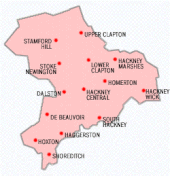|
St John the Baptist, Hoxton
The Church of St John the Baptist, Hoxton, usually known as St John's Hoxton, is an Anglican parish church in the Hoxton area of Hackney, London N1.[2] Nearby is Silicon Roundabout,[3] and also Aske Gardens,[4] named after the parish's major benefactor, City alderman and haberdasher Robert Aske.  Parish historyDedicated to St John the Baptist, its name preserves the memory of a local priory dissolved by King Henry VIII.[5] Robert Aske's legacy still benefits the parish and associated primary school,[6] while Haberdasher Street[7] like Aske Gardens,[8] remain in the memory of his original generosity.[9] One of the 18th-century residents of Hoxton Square,[10] the Revd John Newton, composed the popular hymn "Amazing Grace".[11] Mary Wollstonecraft (1759–97), the writer and philosopher, was born in Hoxton. John Mander, an organ builder, lived at Hoxton and one of his sons, Noel Mander, founded Mander Organs.[12]  (music pub. 1847) In Victorian London the parish's work was recognised by social campaigners, such as the philanthropist Charles Booth, for its welfare work in a deteriorating inner-city environment.[13] Many members of the church[14] became missionaries in Africa and Asia, among them the first Bishop of Chota Nagpur, the Rt Revd Jabez Cornelius Whiteley, whose father, Chaplain to the Haberdashers' Aske's Hospital School formerly located in Pitfield Street[15][16] was the Revd Edward Whiteley: to give opportunities to the "local poor",[17] the parish's first vicar founded what became London's largest savings bank[18] and St John's National Schools[19] which still thrive in India. The maternal great-great-great-grandfather of Kate Middleton (now the Princess of Wales), John Goldsmith, was married to Esther Jones at St John's Hoxton in 1850.[20] The present vicar, the Revd Graham Hunter, serves as an Assistant of the Haberdashers' Company and helps Dame Sarah Mullally, Bishop of London, pioneer the CofE's Health Inequalities Action Group (HIAG) bringing together faith leaders.[21] ArchitectureCompleted in 1826, St John's is a Regency church in the classical style, and the only one built to the design of the celebrated architect, Francis Edwards,[22] Sir John Soane's foremost pupil. A large example of a Commissioners' church, its original floor plan remains intact as well as notable galleries and décor,[23] including a painted ceiling[24] executed in the early 20th century by the architect Joseph Arthur Reeve.[25] Pipe organBuilt and installed in 1915 by the firm of Thomas Sidwell Jones,[26] the organ sits in the choir gallery retaining its original late-Georgian wooden case with an elaborate façade displaying the arms of William IV. Last restored in 1934 by Henry Speechly & Son,[27] St John's organ is known to voice the following stops:
See alsoReferences London Borough of Hackney.
External links
Notes
External links
|
||||||||||||||||||||||||||||||||||||||||||||||||||||||||||||||||||||||||||||||||||||||||||||||||||||||||||||||||||||||||||||||||
Portal di Ensiklopedia Dunia




